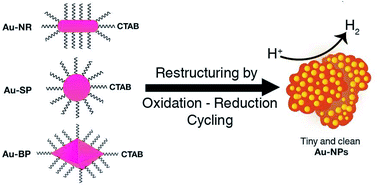Restructuring a gold nanocatalyst by electrochemical treatment to recover its H2 evolution catalytic activity†
Abstract
Gold nanoparticles have been demonstrated to be an attractive alternative to Pt catalyst for the hydrogen evolution reaction in water. Herein, we report a detailed investigation on the impacts of surface chemistry and particle shape on the apparent catalytic activity of gold nanoparticles. To make a fair comparison, the apparent catalytic current densities of gold nanoparticles are normalized by their relative electrochemical surface area, which is determined using either the [Fe(CN)6]3−/[Fe(CN)6]4− redox couple or the underpotential deposition of Pb. Cetyltrimethylammonium bromide-stabilized gold nanoparticles having spherical (Au-SP), rod (Au-NR) or bipyramidal shape (Au-BP) show negligible catalytic activity in a 0.5 M H2SO4 solution. Elimination of the surfactant by dynamic potential cycling between −0.25 to 0 V vs. RHE resulted in a significant enhancement of catalytic activity. The activity slightly depends on the particle shape, e.g. the Au-NR showed higher intrinsic activity as compared with the Au-BP or Au-SP counterparts. A drastic enhancement of activity was achieved when conditioning these gold nanoparticles in a larger potential range, e.g. −0.25 to 1.5 V vs. RHE. Under these conditions, Au-NR and Au-BP were corroded, generating tiny spherical nanoparticles, whereas the Au-SP were corroded, generating a coral-like morphology. The restructured Au-BP, Au-NR and Au-SP showed similar catalytic activities that are among the best performances ever reported for Pt-free catalysts. The best gold catalyst operates with a moderate onset overpotential of 50 mV, high catalytic turnover frequency of 0.56 s−1 at 200 mV overpotential.



 Please wait while we load your content...
Please wait while we load your content...